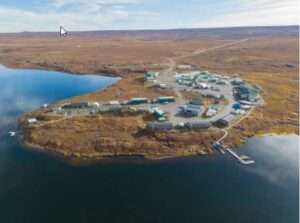
The Russian invasion of Ukraine is biasing predictions of how the Arctic will respond to climate change, according to a team of international scientists, including one from the University of Alaska Fairbanks.
Their study, published Monday, January 22 in Nature Climate Change, compared the ability of Earth systems models to estimate the effects of climate change on eight essential ecological variables, with and without Russian research stations.
“By removing Russia from the picture, we’re really diminishing our ability to understand and respond to Arctic change and its feedbacks on the rest of the world,” said Syndonia Bret-Harte, a professor at UAF’s Institute of Arctic Biology and co-author of the report. “Over the long term, I think there are big hazards associated with this.”
Bret-Harte, who is the science director of UAF’s Toolik Field Station in Arctic Alaska, and her collaborators found that excluding Russian stations from models increased the uncertainty in predictions for almost all of the environmental variables considered. In some cases, the changes were as large or larger than those projected from warming for the next 80 years. Notably, Siberia’s vast taiga forest is not represented, which makes the whole circumpolar region appear to be wetter and to have less plant biomass than it actually does.
“The Arctic isn’t confined to a single country,” Bret-Harte said. “You can’t necessarily predict exactly what the Arctic in Siberia is going to do by only looking at what’s happening in Alaska. Being able to exchange information across international boundaries is really huge.”
Toolik Field Station is one of only two U.S. stations involved in the International Network for Terrestrial Research and Monitoring in the Arctic, a network funded by the European Union known as Interact.
Since 2001, the network has been working to improve representation of the whole Arctic in climate science through a consortium of terrestrial Arctic research stations. Almost 100 field stations, located across the U.S., Canada, Greenland, Scandinavia, Russia and Mongolia, coordinate research and monitoring activities to better understand Arctic change and its impact on local and global communities. Bret-Harte and Toolik joined Interact in the mid-2010s.
Russia’s attack on Ukraine triggered the European Union to limit Interact’s collaborations with Russian researchers and field stations. This has resulted in a gap in ground-based observations of Russian ecosystems.
Since 2022, all 21 Russian stations within Interact have been dropped from its activities. Additionally, the Russian government blocked their scientists from sharing data with international collaborators. Because Russia makes up almost 50% of the Arctic’s total land area, this gap is significant.
“If we don’t have a good idea of what’s going on in half of the Arctic, it’s hard to be confident about our predictions,” Bret-Harte said.
The scientific impacts extend beyond models, Bret-Harte said.
“Having the ability to form these collaborations and work together helps promote an understanding of science and also an understanding of people,” she said. “It’s beneficial both in terms of giving us the best scientific picture that we can get and also in terms of forging connections in different areas of the world and in sharing perspectives.”
With over two decades spent fostering cooperation between Russia and other Arctic researchers, Bret-Harte said that she and her Interact partners remain hopeful that their scientific diplomacy will resume once again across the whole Arctic.
But likely not without losing progress.
“The longer that the war goes on, the harder it’s going to be to reestablish those connections once it ends,” she said.
